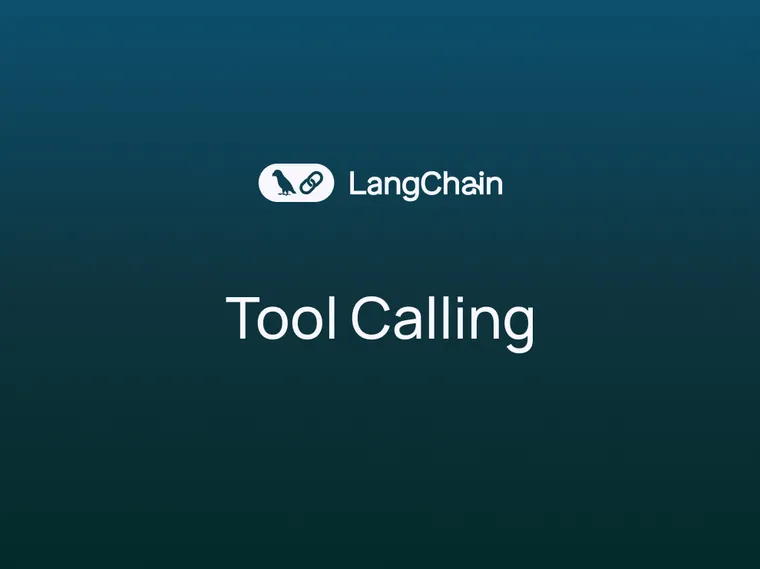TLDR: 我们正在 AIMessage 上引入一个新的 tool_calls 属性。越来越多的 LLM 提供商正在公开用于可靠工具调用的 API。新属性的目标是为与工具调用交互提供一个标准接口。这完全向后兼容,并支持所有具有原生工具调用功能的模型。为了访问这些最新功能,您需要升级您的 langchain_core 和合作伙伴包版本。
Python
- 聊天模型列表,显示工具调用能力的状态
- 工具调用 解释了新的工具调用接口
- 工具调用代理 展示了如何创建一个使用标准化工具调用接口的代理
- LangGraph 笔记本 展示了如何创建一个使用标准化工具调用接口的 LangGraph 代理
JS
简介
大型语言模型 (LLM) 可以通过工具调用功能与外部数据源交互。工具调用是一种强大的技术,允许开发者构建复杂的应用程序,这些程序可以利用 LLM 来访问、交互和操作外部资源,如数据库、文件和 API。
提供商一直在将原生工具调用功能引入他们的模型。实际上,这意味着当 LLM 为提示提供自动补全时,除了纯文本之外,它还可以返回工具调用列表。OpenAI 大约在一年前首次发布了这项功能,最初称为“函数调用”,然后在 11 月迅速演变为“工具调用”。此后,其他模型提供商也纷纷效仿:Gemini(12 月)、Mistral(2 月)、Fireworks(3 月)、Together(3 月)、Groq(4 月)、Cohere(4 月)和 Anthropic(4 月)。
所有这些提供商都公开了略有不同的接口(特别是:OpenAI、Anthropic 和 Gemini,这三个性能最高的模型互不兼容)。我们听到了社区希望有一个标准化的工具调用接口的呼声,以便更容易在这些提供商之间切换,我们很高兴今天发布它。
标准接口包括:
ChatModel.bind_tools():一种将工具定义附加到模型调用的方法。AIMessage.tool_calls:从模型返回的AIMessage上的一个属性,用于轻松访问模型决定进行的工具调用。create_tool_calling_agent():一个代理构造函数,可以与任何实现bind_tools并返回tool_calls的模型一起使用。
让我们来看看这些组件中的每一个。
ChatModel.bind_tools(...)
为了允许模型使用工具,我们需要告诉它哪些工具可用。我们通过向模型传递工具定义列表来做到这一点,包括工具参数的模式。工具定义的具体格式取决于模型提供商——OpenAI 期望一个包含“name”、“description”和“parameters”键的字典,而 Anthropic 期望“name”、“description”和“input_schema”。
ChatModel.bind_tools 提供了一个由所有工具调用模型实现的标准接口,允许您指定哪些工具可供模型使用。您不仅可以传入原始工具定义(字典),还可以传入可以从中派生工具定义的对象:即 Pydantic 类、LangChain 工具和任意函数。这使得创建通用工具定义变得容易,您可以将这些定义与任何工具调用模型一起使用。
from langchain_anthropic import ChatAnthropic
from langchain_core.pydantic_v1 import BaseModel, Field
from langchain_core.tools import tool
# ✅ Pydantic class
class multiply(BaseModel):
"""Return product of 'x' and 'y'."""
x: float = Field(..., description="First factor")
y: float = Field(..., description="Second factor")
# ✅ LangChain tool
@tool
def exponentiate(x: float, y: float) -> float:
"""Raise 'x' to the 'y'."""
return x**y
# ✅ Function
def subtract(x: float, y: float) -> float:
"""Subtract 'x' from 'y'."""
return y-x
# ✅ OpenAI-format dict
# Could also pass in a JSON schema with "title" and "description"
add = {
"name": "add",
"description": "Add 'x' and 'y'.",
"parameters": {
"type": "object",
"properties": {
"x": {"type": "number", "description": "First number to add"},
"y": {"type": "number", "description": "Second number to add"}
},
"required": ["x", "y"]
}
}
llm = ChatAnthropic(model="claude-3-sonnet-20240229", temperature=0)
# Whenever we invoke `llm_with_tool`, all three of these tool definitions
# are passed to the model.
llm_with_tools = llm.bind_tools([multiply, exponentiate, add, subtract])
如果我们想使用不同的工具调用模型,我们的代码看起来会非常相似
from langchain_openai import ChatOpenAI
llm = ChatOpenAI(model="gpt-4-turbo", temperature=0)
llm_with_tools = llm.bind_tools([multiply, exponentiate, add, subtract])
那么调用 llm_with_tools 会是什么样子呢?这就是 AIMessage.tool_calls 的用武之地。
AIMessage.tool_calls
以前在使用工具调用模型时,模型返回的任何工具调用都可以在 AIMessage.additional_kwargs 或 AIMessage.content 中找到,具体取决于模型提供商的 API,并遵循提供商特定的格式。也就是说,您需要自定义逻辑来从不同模型的输出中提取工具调用。现在,AIMessage.tool_calls 提供了一个用于获取模型工具调用的标准化接口。因此,在使用绑定工具调用模型后,您将获得以下形式的输出
llm_with_tools.invoke([
("system", "You're a helpful assistant"),
("human", "what's 5 raised to the 2.743"),
])
# 👀 Notice the tool_calls attribute 👀
# -> AIMessage(
# content=...,
# additional_kwargs={...},
# tool_calls=[{'name': 'exponentiate', 'args': {'y': 2.743, 'x': 5.0}, 'id': '54c166b2-f81a-481a-9289-eea68fc84e4f'}]
# response_metadata={...},
# id='...'
# )
其中 AIMessage 具有一个 tool_calls: List[ToolCall] 属性,如果存在任何工具调用,该属性将被填充,并将遵循工具调用的标准接口
class ToolCall(TypedDict):
name: str
args: Dict[str, Any]
id: Optional[str]
也就是说,无论您调用的是 Anthropic、OpenAI、Gemini 等,只要存在工具调用,它都将以 ToolCall 的形式存在于 AIMessage.tool_calls 中。
我们还添加了一些其他属性来处理流式工具调用块和无效工具调用。在此处的工具调用文档中阅读更多相关信息:此处。
create_tool_calling_agent()
LLM 工具调用功能最强大和最明显的用途之一是构建代理。LangChain 已经有一个 create_openai_tools_agent() 构造函数,可以轻松构建一个使用符合 OpenAI 工具调用 API 的工具调用模型的代理,但这不适用于 Anthropic 和 Gemini 等模型。由于新的 bind_tools() 和 tool_calls 接口,我们添加了一个 create_tool_calling_agent(),它可以与任何工具调用模型一起使用。
from langchain_core.prompts import ChatPromptTemplate
from langchain_core.runnables import ConfigurableField
from langchain_core.tools import tool
from langchain.agents import create_tool_calling_agent, AgentExecutor
@tool
def multiply(x: float, y: float) -> float:
"""Multiply 'x' times 'y'."""
return x * y
@tool
def exponentiate(x: float, y: float) -> float:
"""Raise 'x' to the 'y'."""
return x**y
@tool
def add(x: float, y: float) -> float:
"""Add 'x' and 'y'."""
return x + y
prompt = ChatPromptTemplate.from_messages([
("system", "you're a helpful assistant"),
("human", "{input}"),
("placeholder", "{agent_scratchpad}"),
])
tools = [multiply, exponentiate, add]
llm = ChatAnthropic(model="claude-3-sonnet-20240229", temperature=0)
agent = create_tool_calling_agent(llm, tools, prompt)
agent_executor = AgentExecutor(agent=agent, tools=tools, verbose=True)
agent_executor.invoke({"input": "what's 3 plus 5 raised to the 2.743. also what's 17.24 - 918.1241", })
我们可以改用 VertexAI
from langchain_google_vertexai import ChatVertexAI
llm = ChatVertexAI(
model="gemini-pro",
temperature=0,
convert_system_message_to_human=True
)
agent = create_tool_calling_agent(llm, tools, prompt)
agent_executor = AgentExecutor(agent=agent, tools=tools, verbose=True)
agent_executor.invoke({"input": "what's 3 plus 5 raised to the 2.743. also what's 17.24 - 918.1241", })
或者 OpenAI
llm = ChatOpenAI(model="gpt-3.5-turbo-0125", temperature=0)
agent = create_tool_calling_agent(llm, tools, prompt)
agent_executor = AgentExecutor(agent=agent, tools=tools, verbose=True)
agent_executor.invoke({"input": "what's 3 plus 5 raised to the 2.743. also what's 17.24 - 918.1241", })
等等。
有关新代理的完整文档,请参见此处。
LangGraph
如果您还没有了解 LangGraph,您绝对应该了解一下。它是 LangChain 的扩展,可以轻松构建任意代理和多代理流程。您可以想象,使用新的 tool_calls 接口也使构建 LangGraph 代理或流程变得更简单。查看此处的笔记本,详细了解如何在 LangGraph 代理中使用 tool_calls。
with_structured_output
我们最近发布了 ChatModel.with_structured_output() 接口,用于从模型获取结构化输出,这与工具调用非常相关。虽然具体实现因模型提供商而异,但对于大多数支持它的模型,with_structured_output 都是基于工具调用构建的。在底层,with_structured_output 使用 bind_tools 将给定的结构化输出模式传递给模型。
那么,您应该何时使用 with_structured_output,何时直接绑定工具并读取工具调用呢?
with_structured_output 始终返回您指定的模式中的结构化输出。当您想强制 LLM 输出与特定模式匹配的信息时,这很有用。这对于信息提取任务很有用。
bind_tools 更通用,可以选择特定工具 - 或不选择工具,或选择多个工具!当您希望允许 LLM 在如何响应方面具有更大的灵活性时,这很有用 - 例如,在代理应用程序中,您需要选择要调用哪些工具,还要响应用户。
结论
我们预计将原生工具调用功能引入 LLM 的趋势将在未来继续。我们希望标准化的工具调用接口可以帮助 LangChain 用户节省时间和精力,并使他们能够更轻松地在不同的 LLM 提供商之间切换。
请记住更新您的 langchain_core 和合作伙伴包版本,以利用新的接口!
我们很乐意倾听您的任何反馈!

